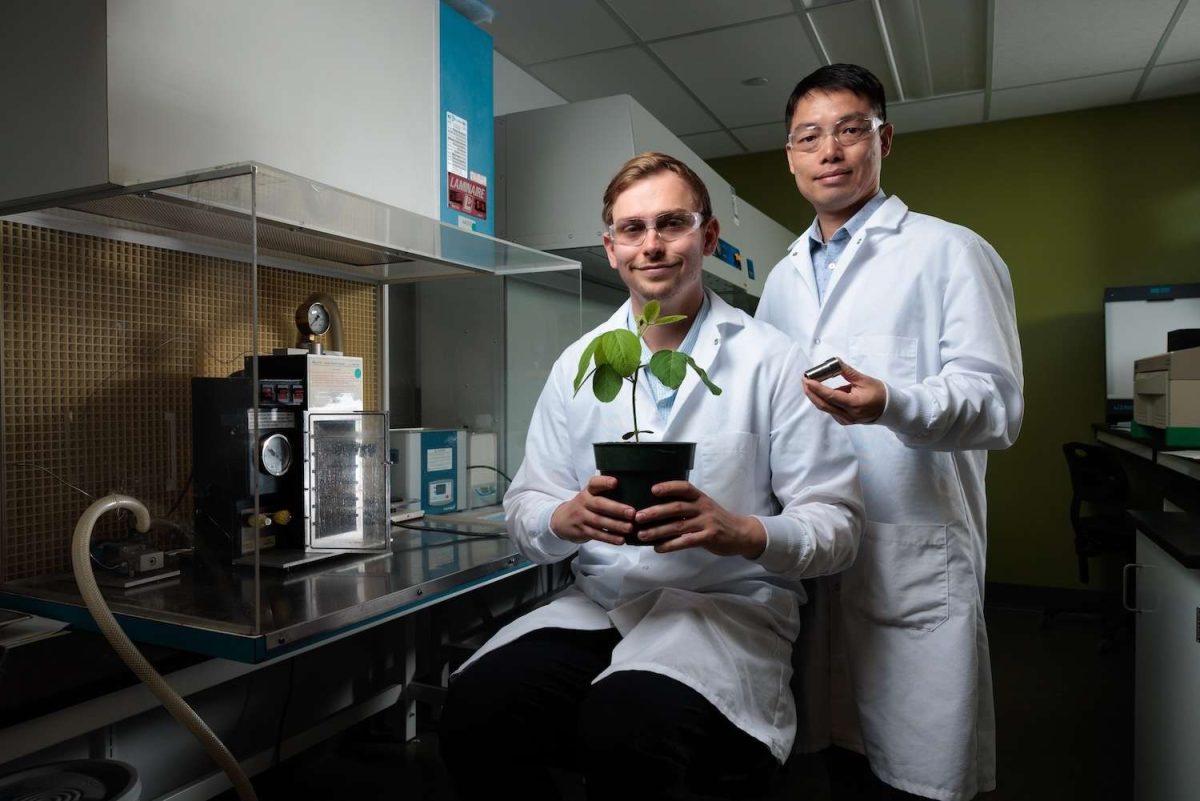A new Ames start-up is offering a product with the potential to make new waves in the world of editing plant genetics.
Hermes Biomaterials sprouted from a research project at Iowa State University looking into ways to improve the delivery of genetic code into plant cells. The startup is now offering products that promise to significantly boost the delivery and efficiency of genetic information into plants.
Today, genetically modified plants make up a majority of the agricultural production in Iowa, drastically increasing the crops farmers are able to produce and their resistance to environmental factors such as droughts or pests.
Genetic modifications are made to plants through a process called biolistic delivery, which includes using a high-pressure “gene gun” to shoot a small particle loaded with DNA into a plant cell, with the intent of incorporating some of the DNA into its genetic makeup.
While this process has led to huge improvements in crop production over the past 40 years, it is still far from perfect, and often ends in plant cells failing to incorporate foreign DNA into their genome.
Shan Jiang, a credited founder and inventor at Hermes Biomaterials, chose to use his background delivering genetic code to animal cells to try to find new ways to improve the plant genome editing process when he started working at Iowa State as an associate professor of materials science and engineering.
The creation process
What makes this process more challenging is the much more rigid cell wall that plants have to provide structural support and protection. In order to penetrate the cell wall with genetic material, scientists have to shoot a dense particle coated in genetic material at high velocity, often destroying the cell in the process.
“So you’re using brute force, you almost destroy all your tissue, but a few cells left behind survive,” Jiang said. “They can grow into new plants.”
The idea is that the few surviving cells begin to express the genes provided through the biolistic delivery, not just temporarily but in their offspring as well.
The research project first revolved around the delivery agents used to bind genetic code to the particle that acts as the vehicle to enter the cell, but Jiang and his team of researchers soon found that the inconsistency of the gene gun prevented them from obtaining any meaningful results. From there, the team’s focus shifted to the gene gun itself.
Connor Thorpe, a founder of Hermes Biomaterials and a credited inventor of the new gene gun, was assigned the research project as a part of his Ph.D. program in materials science and engineering.
Coming from Arizona State with a background in the same discipline, Thorpe said when the test results across the 80 or so molecules they were studying came back nearly identical, he knew the results were not true, and decided they must have been related to the inconsistency of the gene gun.
“I was immediately panicking,” Thorpe said. “I was like, oh my god, I’m never going to be able to graduate if I’m using this device for my research. So then I basically had no choice, and I immediately started looking into the gun.”
Thorpe said he created a 3D model of the gun and loaded it into a simulation software that allowed him to see particle flows within the device, which allowed him to pinpoint the issue.
“The design was a little faulty, actually quite faulty, and worked, but it didn’t work very well,” Thorpe said.
Finding the design: Thorpe began 3D printing hundreds of designs for an improved gene gun at home before testing them at the lab, eventually finding a design that drastically improved the gene gun’s ability to penetrate the cell wall without obliterating it.
Jiang said after Thorpe began running tests with a modified gene gun, he was able to demonstrate impressive improvements to the delivery of DNA, starting with a 50% improvement and eventually seeing a 20 times increase in efficiency of delivering genetic information.
The process becomes a success
Solidifying the success even further, Jiang said, through collaborations with the Department of Agronomy and others outside the university, they were able to confirm that the modified gene gun not only improved the delivery of genetic code but also led to a more stable expression of the genes in the cells’ offspring.
“I would say that in the middle of the study, at some point, we really, I at least, felt that nothing worked, and we may just give it up, and it’s not a great idea because it’s so hard to make it work,” Jiang said. “But eventually we pushed through, and I think the result was very impressive.”
After the studies: Jiang said he and his colleagues wanted to take their findings into the community and agricultural industry to be able to offer a better way of biolistic delivery to plant biologists.
“So in order for people to really utilize this technology, they want something durable, very consistent, very reliable, and it won’t be possible to do it within a lab setting. You have to go to industry to do it.” Jiang said. “That’s why that prompted us to start to think about commercialization and protect the technology, and that’s what we did.”







